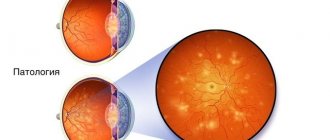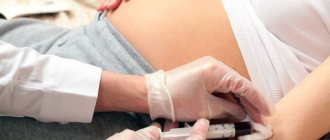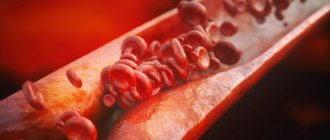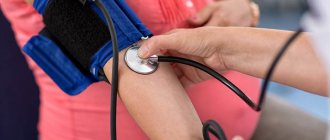Cholesterol is a fat-like organic compound found in the cell membranes of the body. Cholesterol plays an important role in the body and ensures the stability of the cell membrane. The production of vitamin D, testosterone and estrogen, progesterone would not be possible without this organic compound.
Cholesterol is produced to a greater extent by the liver, kidneys, and adrenal glands. The remaining percentage of the organic compound enters the body from food. High cholesterol during pregnancy is a natural process caused by the development of a new life.
Complexes with this research
Biochemistry of blood.
19 indicators Advanced biochemical blood test 6,280 ₽ Composition Expanded hospital complex Expanded infectious screening for prevention and hospitalization 7,700 ₽ Composition
Check-up No. 1 for children and adolescents Annual preventive examination program RUB 10,950 Composition
IN OTHER COMPLEXES
- Biomarkers of liver functional capacity. Extended examination RUB 3,900
- Cola and chips 3,020 ₽
- Biochemistry of blood. 8 indicators 990 ₽
- Preventative check-up RUB 11,960
- Diabetes monitoring RUB 1,900
How can you reduce cholesterol?
By following your doctor's recommendations, monitoring your diet, undergoing tests and donating blood to control cholesterol levels, you can quickly reduce the high level of fat-like organic compounds in pregnant women. When reducing high cholesterol concentrations, it is important not to forget about the safety of the mother and her baby.
During this period, it is highly undesirable to use medications. An increased level of an organic compound can only cause harm if it is in excess. The use of medicines and folk remedies should be moderate so as not to cause severe stress to the body during a difficult period.
Is it possible to normalize the level without medications?
To reduce cholesterol, experts advise eliminating from the diet:
- fatty foods;
- fried foods and pickles;
- sweets (cakes, sweets, pastries, croissants and buns);
- butter;
- Palm oil;
- fast foods;
- sausages and pates;
- semi-finished products;
- pork
Physical exercise can help balance the balance of bad and good cholesterol. During pregnancy you can do:
- aerobics;
- fitness;
- yoga;
- special gymnastics;
- swimming.
If any unpleasant symptoms appear, you should immediately consult a doctor
Physical activity will help normalize lipid metabolism and reduce weight. Green tea, freshly squeezed fruit juice, fruits, and vegetable juice can have a beneficial effect on the metabolic process and reduce the level of fat-like organic compounds.
Very often, during a difficult pregnancy, severe toxicosis and weakness, a woman least of all thinks about the recommendations of specialists. Snacking on your favorite food on the go, it involuntarily increases cholesterol in the blood even more. And this causes an increase in the frequency of vomiting and unpleasant painful sensations in the abdominal area.
The main part of cholesterol in a pregnant woman is synthesized independently in the body. Excess compounds come precisely from eating junk food. While carrying a baby, it is unacceptable to eat too much. It is best to eat in small, fractional portions.
The basis of the diet should be foods containing omega-3 and omega-6. Such foods include sea fish, flax seeds, and flaxseed oil. By following simple rules, you can prevent the development of pathologies when carrying a child, keep your weight and cholesterol levels under control.
When should you take a total cholesterol test?
- Diabetes;
- Obesity;
- Thyroid diseases;
- Myocardial infarction or stroke in close relatives;
- Long-term smoking;
- Alcohol abuse;
- Chronic liver and kidney diseases;
- Poor diet with excess fatty foods;
- The presence of a chronic inflammatory process;
- Comprehensive assessment of health indicators in people without risk factors for cardiovascular diseases;
- Assessment of changes in cholesterol levels over time due to diet and/or treatment.
Norms during pregnancy
The main indicators of cholesterol levels in the body during pregnancy include:
- total cholesterol indicator (3.08-13.8 mmol/l);
- the level of the atherogenic coefficient, reflecting the ratio of bad and good cholesterol (0.4-2.5 units);
- fatty acid content indicator (0.4-2.2 mmol/l).
A wide range of cholesterol levels during pregnancy may be due to a number of reasons. The indicator is influenced not only by the age category of the pregnant woman, but also by the duration of pregnancy. Below is a table with norms in the first, second and third trimester of pregnancy.
Normal cholesterol levels in pregnant women
| Age category | First months of pregnancy | 2-3 trimester of pregnancy |
| 17-20 years old | 3.07 - 5.19 mmol/l | 3.07 - 10.38 mmol/l |
| 20-25 years | 3.17 - 5.6 mmol/l | 3.17 - 11.2 mmol/l |
| 25-30 years | 3.3 - 5.8 mmol/l | 3.3 - 11.6 mmol/l |
| 30-40 years | 3.4 - 5.97 mmol/l | 3.7 - 12.6 mmol/l |
| 35-45 years | 3.9 - 6.9 mmol/l | 3.9 - 13.8 mmol/l |
During pregnancy, part of the diagnosis is in the range of cholesterol 7 mmol/l or cholesterol 9 mmol/l. Both indicators are normal!
Detailed description of the study
Cholesterol is a fat-soluble compound that performs many functions necessary for normal cell function. It serves as an important component of the cell membrane: it helps maintain the structure of the membrane and also changes its viscosity.
The functions of cholesterol in the body are diverse. It is a precursor molecule in the synthesis of vitamin D, steroid hormones (eg, cortisol, aldosterone, and adrenal androgens), and sex hormones (eg, testosterone, estrogens, and progesterone). Cholesterol is also part of bile salts, which are needed to digest food and improve the absorption of fat-soluble vitamins A, D, E and K.
Maintaining cholesterol levels in the blood occurs largely due to its synthesis in liver cells (70-80%). Therefore, the content of this substance in the body depends on the condition of the liver, and is also predetermined by genetic factors. Cholesterol levels are not very different between men and women, but may increase with age.
In the liver, cholesterol combines with carrier molecules (lipoproteins) and enters the blood, then into cells and tissues to perform its functions. Although this compound plays an important role in the body, it can also have harmful effects when present in excess in the blood. This condition is called hypercholesterolemia.
Hypercholesterolemia increases the risk of cardiovascular disease and its complications, such as myocardial infarction or stroke. A predisposing disease for this is vascular atherosclerosis, that is, the formation of cholesterol-containing plaques that can block the lumen of the arteries and increase the risk of blood clots. The presence of high sugar (glucose) in the blood, impaired liver function and decreased production of thyroid hormones contribute to increased cholesterol in the blood and the development of atherosclerosis.
Hypercholesterolemia usually does not show any symptoms until the atherosclerotic plaque causes complications in the heart (myocardial infarction) or blood vessels: stroke, dizziness due to impaired blood flow in the vessels of the neck, intermittent claudication due to damage to the arteries of the lower extremities. Some people may notice accumulations of fatty tissue under the skin (xanthomas) and yellowish plaques on the eyelids (xanthelasmas). These benign formations are usually considered a cosmetic defect, but they reflect a disorder in the metabolism of cholesterol in the body.
Studying the level of cholesterol in the blood is important for the timely detection of fat disorders in the body and the prescription of treatment to prevent damage to the blood vessels of the heart and other various organs.
What causes cholesterol levels to increase?
A healthy woman's body contains approximately 4.138 mmol/L cholesterol. This indicator indicates the normal functioning of organs and systems and the absence of serious health problems. Why does the level of the substance increase? During pregnancy, cholesterol may rise slightly above the permissible norm.
This occurs against the background of the fact that the kidneys and liver begin to work harder due to hormonal changes. The adrenal glands are not able to cope with the elimination of excess and when taking tests, you can see an increase in a fat-like organic compound. During the period of bearing a baby, the normal cholesterol level is considered to be 3.20 - 14 mmol/l.
The organic compound indicator may increase depending on the age category of the pregnant woman. An organic fat-like compound plays an important role for the body of a woman carrying a child. Cholesterol is involved in the formation of the placenta, where the baby grows and develops. Cholesterol takes an active part in the synthesis of hormones.
Very often, the cholesterol level of the expectant mother increases by 1.5-2 times.
If a woman feels well and does not experience any symptoms, then a decreased or increased indicator in this case will not indicate a pathological condition. The amount of cholesterol affects the health of the expectant mother and is responsible for the intrauterine development of the baby.
To lower cholesterol you will need to follow a special diet
Painful attacks during hepatosis
In the most difficult cases of hepatosis, the patient sometimes experiences attacks characterized by severe pain in the right hypochondrium. Often the pain is felt in the abdomen, at the level of the navel and is mistaken for an exacerbation of gastritis. Such attacks may be accompanied by continuous and painful vomiting without relief, headache, tinnitus, rapid heartbeat, darkening of the eyes and shortness of breath. They are very similar to severe poisoning syndrome, only in this case the stool practically does not change, and the food eaten is vomited.
Most often, such attacks are caused by eating harmful foods (fried, spicy, fatty, alcohol) and begin 40-60 minutes after eating or by a sudden movement, for example, a quick turn, bend or fall. Painful attacks can last up to 20-40 minutes, they begin suddenly and recede just as sharply. Often after an attack, quite severe residual pain remains in the right hypochondrium for several days. A big mistake during such attacks is taking paracetamol, because it only aggravates the situation, negatively affecting liver activity. It is allowed to take antispasmodic drugs such as No-Shpa.
Take the first step
make an appointment with a doctor!
Prevention and treatment
As a preventative measure, experts recommend paying attention to your own diet, which should be based on seasonal fresh fruits and vegetables. For prevention purposes, it is better to completely avoid coffee drinks and minimize the consumption of eggs, fried foods and sweets.
If proper nutrition does not help reduce the level of fat-like organic compounds, you should consult with your doctor, who will select special medications and prescribe a course of therapy.
High cholesterol during pregnancy requires careful attention, although it is the norm. As soon as unpleasant symptoms begin to bother you, you should immediately take measures to normalize the concentration level of this substance, which will help avoid unpleasant consequences for both the expectant mother and the child.
Diagnosis of hepatosis and its signs
Hepatosis in pregnant women is a disease that is sometimes very difficult to diagnose. By this time, the uterus already occupies the entire abdominal cavity, which makes palpation of the liver impossible. This disease is often confused with gallstone disease, because their symptoms are very similar. The most common signs of hepatosis include:
- skin itching;
- yellowing of the skin and whites of the eyes, the appearance of vascular networks on the face and hands, redness of the palms (they seem to be covered with red spots from the inside);
- nausea, vomiting, abdominal discomfort, bitterness in the mouth, stool disorders, loss of appetite;
- pain in the right hypochondrium;
- lightening of stool and darkening of urine (from orange to dark brown);
When the bile duct is disrupted, a large amount of bile accumulates in the liver. Unable to escape, bile begins to break through into the lymphatic system, and from there into the general bloodstream. If you conduct a blood test, it will show an increase in the level of transaminases, alkaline phosphatase, bilirubin and cholesterol, a decrease in hemoglobin, as well as red blood cells and platelets. A urine test will reveal the presence of bile acids and increased secretion of urobilin.
When bile enters the bloodstream, it causes itching, which intensifies in the evening and at night. Most often, pregnant women with this disease consult a doctor with complaints of an acute and irresistible desire to scratch. It drives you crazy, disrupts sleep, leads to fatigue and irritation. As a rule, the arms, legs and stomach itch the most. Filling the liver with bile causes overstretching of its capsule, the surface of which has a large number of pain receptors. This causes constant dull pain in the right side.
If hepatosis is suspected, the doctor at the antenatal clinic should carefully examine the patient, try to palpate the liver area, prescribe extensive blood and urine tests, as well as an ultrasound examination of the liver, gall bladder and neighboring organs.
What drugs lower cholesterol?
Only a doctor can correctly assess the content of this substance and lipoproteins when prescribing laboratory tests. Blood is taken from a peripheral vein to determine the level of low and high density lipoproteins, triglycerides, and cholesterol. The drugs described in the article can only be prescribed by a specialist. The information is provided for informational purposes only.
Statins
The first group is for lowering cholesterol levels. The action of these drugs is aimed at reducing the synthesis of cholesterol in the liver by suppressing the activity of HMG-CoA reductase. With a decrease in cholesterol concentration, the number of receptors for low-density lipoproteins on the surface of liver cells increases, which affects the decrease in the amount of the cholesterol-LDL complex. Statins have a strong evidence base, with many clinical studies showing greater benefits from taking these drugs than the risk of complications with constant use. This group of drugs is the first line in the fight against atherosclerosis. They are also prescribed to prevent unfavorable vascular situations - myocardial infarction, thrombosis, stroke.
Statins are prescribed to prevent vascular pathologies.
Examples of such drugs are:
- Crestor;
- Atoris;
- Livazo;
- Mertenil;
- Liprimar.
Bile acid sequestrants
The mechanism of action is to reduce the absorption of cholesterol in the intestinal lumen. The earliest drugs are cholestyramine and colestipol, resins that bind bile acids to cholesterol in the intestine. These drugs are not absorbed into the systemic circulation and their effect is indirect.
Cholesterol absorption inhibitors
The essence of the interaction of these drugs with cholesterol is to block its absorption in the intestine. However, the drugs do not affect the absorption of other fat-soluble substances.
An example of this group is Ezetrol.
Omega 3 fatty acids
These drugs reduce the concentration of low-density lipoproteins, but the mechanism of their action is poorly understood.
A representative of this group of drugs is Omacor.
A nicotinic acid
This drug is associated with an increase in the level of “good” cholesterol by partially breaking down through an increase in the specific substance apoA1 in liver tissue. The drug has shown its effectiveness in clinical studies (Nicotinic acid tablets).
Treatment of hepatosis in pregnant women
Treatment of hepatosis is complicated by the fact that almost all medications are contraindicated for pregnant women. Many medications can cause hypoxia and intrauterine growth retardation in the fetus, so the doctor must conduct a full examination of the patient and make sure the diagnosis is correct before deciding on a treatment method. It is very important to understand at what stage the disease is. In the mild stage, you can do without drug intervention by using a special diet. The expectant mother should exclude all heavy, fatty and high-calorie foods from her diet, and also stop taking vitamin complexes and other medications (if their withdrawal does not harm the pregnancy). Drugs designed to optimize liver function are also often prescribed (Hofitol, Essentiale Forte N and others). In many cases, diet is enough to remove toxins from the body and improve the patient's condition.
In more severe stages, the woman is sent to a hospital, where the issue of early delivery is decided. If there is no danger to the fetus, then labor can be delayed by purifying the blood using IVs. They are combined with taking large doses of the above-mentioned drugs and a strict diet. If this technique makes it possible to suppress the disease or at least keep it at the same level of development, and the condition of the fetus does not cause concern, then treatment is continued until 37-38 weeks, and childbirth is planned for this period. If the method does not give the desired result (or if the condition of the fetus worsens, hypoxia is clearly visible), consent to induced labor or Caesarean section is urgently signed. Often the child has a defensive reaction to the unfavorable situation created, and premature birth spontaneously begins. However, you should not rely only on nature. If serious indications arise, it is recommended to start the labor process in advance to minimize the risk of complications.
It is very important that a pregnant woman with severe hepatosis is under constant medical supervision. It is also necessary to carry out extensive blood tests every two days. It often happens that under the influence of IVs, blood counts suddenly drop significantly. Having decided that the disease has subsided, the doctor discharges the patient, and after a couple of days she is again admitted to the hospital with a sharp increase in transaminases.
Take the first step
make an appointment with a doctor!









